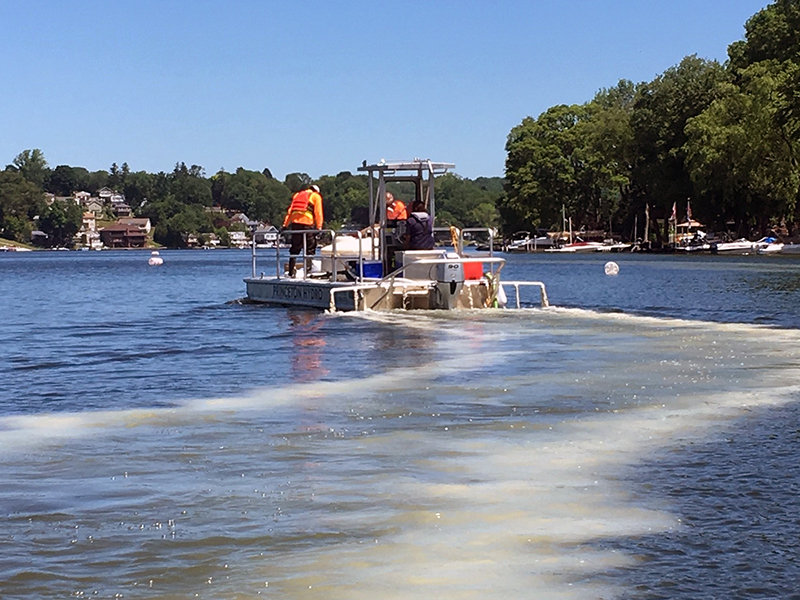
April 25, 2025| Community, Environment
By: Kyle Richter
A new pilot project is beginning this spring on Lake Hopatcong to reduce harmful algal blooms (HABs) in shallow, near-shore areas. HABs are overgrowths of algae that can sometimes produce toxins and make the water unsafe for people, pets, and wildlife. The project is led by Princeton Hydro, in partnership with the Lake Hopatcong Foundation, Lake Hopatcong Commission, and New Jersey Department of Environmental Protection, with funding from the U.S. Army Corps of Engineers. It focuses on testing innovative treatments to improve water quality.
Lake Hopatcong has already seen successful efforts to manage nutrients through watershed projects that reduce runoff and deep-water treatments like aeration and nutrient inactivation to address phosphorus released from the lakebed in low-oxygen conditions. These strategies provide a strong return on investment by targeting nutrient issues across the lake. However, shallow, near-shore areas where algae form remain a challenge. This new pilot project will test treatments using algaecides, coagulants, and phosphorus-binding products to explore new methods for reducing HABs in these nutrient-rich shallow areas.
Over the spring and summer, six treatment methods will be tested in several coves and bays. Each method is designed to prevent algae growth or reduce it quickly if it appears. Here’s what to expect:
During the project, you may see small boats applying treatments in the coves. The products used are not pesticides—they are approved for use in lakes, safe when applied as directed, and specifically designed to improve water quality. Monitoring will take place throughout the season, with follow-up testing one week, one month, and one year after each treatment. While no lake-wide closures are expected, signs may be posted in treatment areas as a precaution, depending on the product used.
This pilot project aims to identify the most effective strategies for managing shoreline HABs, which could benefit not only Lake Hopatcong, but also other lakes across New Jersey and the Mid-Atlantic.
The following FAQs were prepared by Princeton Hydro to provide additional details about the pilot project water treatments to reduce harmful algal blooms (HABs) in shallow, near-shore areas.
Q: What are the benefits of this project?
A: These are demonstration projects to evaluate the cost-effectiveness of proactive and innovative measures to prevent, control, and/or mitigate harmful algal blooms (HABs). By evaluating these treatments here, Lake Hopatcong gains the immediate benefits of nutrient reduction and improved water quality, while also contributing valuable data that will guide future HAB management decisions and inform long-term strategies to help prevent and mitigate shoreline HABs.
Q: What will the lake be treated with?
All of the products being used are commonly used as nutrient inactivators and/or water clarifiers that have been fully approved by the NJDEP. Permits have been obtained from NJDEP for all applied products prior to the start of treatment.
In Spring 2025, Crescent Cove and Ashley Cove will receive treatments that were placed on the lake bottom to stop algae before it forms. One used a chelated, copper-based product, and the other used an oxidizer (a product that breaks down algae).
In September and October, four types of treatments will be conducted. In Landing Channel and the northern part of Woodport, non-pesticidal products will be used to trap phosphorus (a nutrient that feeds algae) and cyanobacteria in the sediments. In Van Every Cove and Great Cove, which are both known for algae issues, the treatments start by killing the cyanobacteria in the water with an oxidizer, then adding materials to settle and trap nutrients in the sediment below.
Q: How will the treatments be monitored?
Princeton Hydro will monitor each treatment area after one week, one month, and one year to track results and effectiveness.
Q: Can the lake still be used during/after the treatments?
A: There are no temporary use restrictions for any of the treatments; however, Princeton Hydro recommends not drawing water from the lake within the treatment zone within 24 hours of treatment, out of an abundance of caution, and to ensure a successful and even application.
Q: Who is conducting the treatment?
A: Princeton Hydro and Ready Scout, LLC are conducting the treatments. Ready Scout will conduct the GreenClean applications, and Princeton Hydro will apply all other products.
Q: Are the treatment applicators wearing Hazmat suits?
A: No, they are not wearing hazmat suits. You may see applicators wearing personal protection equipment (PPE) (i.e., gloves, respirators, long pants). Depending on the product used, different PPE may be required. Additionally, you may see the contractors in bright yellow rain gear to stay dry if it is raining or warm.
For example, one of the treatment methods uses the liquid oxidizer algaecide GreenClean 5.0 formula, which is highly concentrated, so PPE is required. Once the formula reacts with the water, it begins to break down into water and oxygen immediately, and is not hazardous. This is the same product that was used to effectively treat the harmful algal bloom in Crescent Cove a few years ago.
Q: How was the public notified?
A: Signs will be posted in the treatment areas and/or at the staging locations, and ads will be placed in the New Jersey Herald, as required in the project’s Harmful Algal Bloom Management Permit and Pesticide Application Permit. In addition to the requirements, the Lake Hopatcong Foundation and Lake Hopatcong Commission will post on their respective Facebook pages. The Lake Hopatcong Foundation will also post blogs (April, September, October) with detailed information about the treatments before commencement.
Q: Who is funding this project?
A: The cost of a project of this scale, which can often be prohibitive, is being fully funded by the U.S. Army Corps of Engineers’ Engineer Research and Development Center, through funding secured by Princeton Hydro. The Lake Hopatcong Commission and Lake Hopatcong Foundation are supporting the project through coordination and outreach, but no local funds are being used.

September 12, 2025
Environment

October 02, 2025
Community, Environment